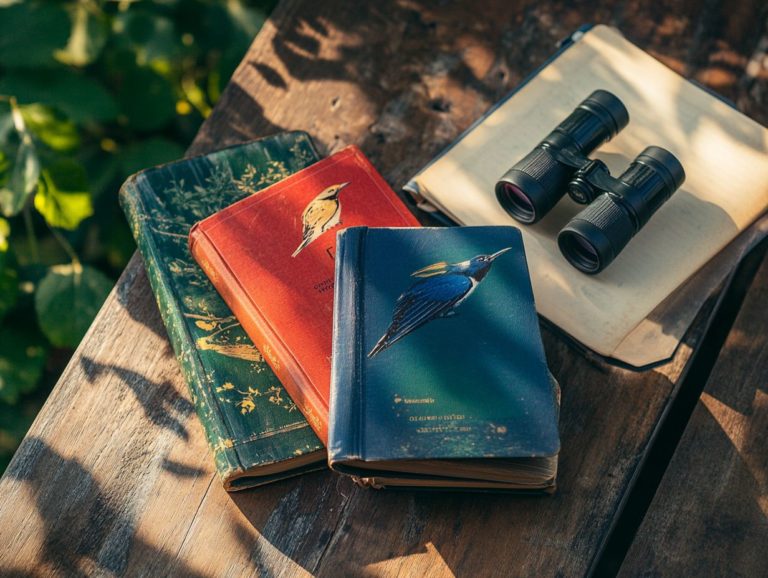Field Guide Essentials: What to Look For
Field guides are indispensable companions for nature enthusiasts. They provide crucial insights into the flora and fauna around you.
With many options available, choosing the right guide can feel overwhelming. This article simplifies the process by outlining essential features of a quality field guide.
You will find practical tips to help you maximize your guide, ensuring every outdoor adventure is fulfilling. Get ready to transform your explorations with the perfect field guide. Let s dive in!
Contents
Key Takeaways:

- Always consider size, subject matter, and detail level when choosing a field guide.
- Look for organized information and clear visual aids, such as illustrations and maps.
- A field guide must have comprehensive species descriptions, but tools like a magnifying glass can enhance your experience.
What is a Field Guide?
A field guide is an invaluable asset for you as a nature enthusiast or amateur naturalist. It offers a wealth of information on various aspects of the natural world, including plants, animals, and minerals.
Renowned guides like the Peterson Field Guides and those from the National Audubon Society are essential tools for identifying species. They enable you to explore local ecosystems and grasp the intricate relationships in nature.
With detailed illustrations, photographs, and drawings, these guides assist in accurately identifying native species. This makes them critical for wildlife observation and nature study.
Historically, field guides have nurtured an appreciation for nature, connecting scientific inquiry with everyday observation. Armed with well-researched descriptions and visuals, these guides elevate your outdoor experiences.
Covering a wide range of subjects from birds and butterflies to wildflowers and rocks field guides cater to diverse interests. They provide visual identification and ecological insights, deepening your understanding of biodiversity and conservation.
Choosing the Right Field Guide
Choosing the right field guides is essential for effective species identification. It can greatly elevate your experience, whether you’re just starting as a naturalist or have years of wildlife observation.
Consider the type of educational resources you need. Focus on regional guides that align with the ecosystems you ll be exploring. Reflect on your particular interests, whether in butterfly identification or botany.
Your choice will enhance your understanding and enrich your connection to the natural world.
Factors to Consider
When selecting a field guide, consider top features to look for to ensure it meets your needs for effective species identification and appreciation of the ecosystem.
Look for identification options tailored to your region and pay attention to the habitat requirements of different species. Prioritize clarity in visual features, such as illustrations and photographs, to enhance your understanding.
An effective guide should explain the roles species play in their environments. This helps you understand how species interact within their ecosystems.
Understanding the importance of pollinators, like bees, and decomposers, such as mushrooms, deepens your appreciation for these organisms. Recognizing how they contribute to their environments helps you observe patterns and behaviors during outings.
A guide that explains these dynamics aids in species identification and fosters a deeper connection to nature. This enriches your experience as you engage in wildlife observation and nature study.
Essential Features of a Field Guide

When considering the essential features of a high-quality field guide, look for clear organization, comprehensive content, and effective educational tools. For new bird watchers, utilizing field guides with helpful tips can assist in quick and accurate species identification.
A well-structured guide typically utilizes a logical identification system and provides practical tips for identifying species. For those new to the hobby, a beginner’s guide to birdwatching may even offer folding guides for convenience in the field.
This thoughtful design ensures that whether you are an amateur naturalist or a seasoned wildlife observer, you can navigate through the diverse array of natural objects with ease.
Information and Organization
The organization of information within a field guide is crucial for quickly identifying the common species that inhabit local ecosystems. A well-designed identification system enhances your experience and allows you to locate necessary details swiftly.
When high-quality wildlife photography accompanies this information, it elevates the visual learning process, making it more engaging. This logical structure helps you identify a species on the spot and deepens your understanding of how species interact with their environment.
With clearly presented information, you can rely on visual cues and concise data for informed observations in the field. Quality wildlife photography acts as a compelling educational tool, showcasing intricate details and igniting your curiosity while fostering a sense of stewardship toward nature.
Ultimately, a thoughtfully organized field guide transforms your experience from simple identification to meaningful engagement with the environment.
Visual Aids and Illustrations
Visual aids like illustrations and drawings are essential in field guides, acting as immediate reference points for you as you strive to identify various species outdoors. High-quality educational resources with accurate drawings enable you to distinguish between similar species and recognize key field marks critical for identification.
These visual elements enhance your engagement, transforming the often daunting task of species identification into an enjoyable and accessible journey. Effective illustrations capture behavior and habitat nuances, revealing insights that text alone can t deliver.
To ensure reliable information, assess the quality of illustrations by examining factors such as clarity, detail, and scientific accuracy. Seek out guides that provide comparisons between species to simplify the identification process. This turns your exploration into an experience that is both educational and profoundly captivating.
Field Guide Must-Haves
Equip yourself with several critical features and tools that enhance your experience. This allows you to dive into learning and exploring the wonders of nature!
A reliable field guide, nature journals for documenting your insights, and a solid grasp of ecological roles are vital components for any nature enthusiast looking to deepen their appreciation of local ecosystems.
Explore your local area with your guides to enhance your learning experience. Visual elements make the guide more enjoyable, reinforcing your connection with nature.
Basic Necessities for Any Field Guide

A well-crafted field guide has a structured layout. It includes essential resources and clear habitat information about different species.
As a beginner, simplified content makes naturalism more accessible, allowing you to dive into your local ecosystems with confidence.
An intuitive navigation system is key to enhancing your experience. It enables you to quickly find the information you need.
Each section should present species in a logical order, perhaps organized by type of species or habitat type. This facilitates a seamless flow of knowledge.
Visual aids, such as photographs or illustrations, reinforce your learning. They help you recognize key characteristics of various flora and fauna.
Including tips for responsible observation practices encourages ethical interactions with nature. This fosters a deeper respect for local wildlife.
Ultimately, these elements enrich the field guide. They nurture your curiosity and strengthen your connection to the environment as a novice enthusiast.
Additional Tools and Resources
In addition to field guides, you ll find a treasure trove of supplemental tools and resources. These elevate your wildlife observation experience and deepen your understanding of the natural world.
Many environmental centers are eager to provide guide recommendations and access to enriching educational programs.
If you’re keen on exploring flora, botanical key systems offer a nuanced approach to plant identification.
Online platforms like iNaturalist and eBird enable you to document observations and connect with a vibrant community of nature enthusiasts. This fosters a shared passion and expands your knowledge.
These platforms allow you to upload photos and data, inviting feedback from experts that will significantly boost your identification skills.
Local community programs frequently host guided hikes and workshops. They offer practical identification strategies from seasoned naturalists.
By integrating these diverse resources into your explorations, you broaden your understanding and cultivate a richer relationship with the environment surrounding you.
Tips for Using a Field Guide
To unlock the potential of a field guide, implement effective tips and strategies. They significantly enhance your identification accuracy and enrich your overall nature study experience.
Utilizing targeted identification techniques, engaging with educational tools, and applying best practices in wildlife conservation enable you whether a novice or an experienced naturalist to delve deeper into local ecosystems and species identification methods.
Maximizing the Benefits of a Field Guide
Maximizing the benefits of a field guide means actively engaging with the content. Utilize educational resources to make informed identification choices tailored to specific habitats and species.
Immerse yourself in nature study and hone your wildlife observation skills. You ll not only enhance your ability to identify species but also cultivate a deeper appreciation for biodiversity.
Participate in workshops spotlighting local flora and fauna. Collaborate with fellow enthusiasts and regularly visit diverse ecosystems to witness seasonal changes.
Embrace online platforms and apps to boost your documentation skills and broaden your knowledge base.
Adopt a mindset of continuous learning by exploring natural history. This approach deepens your understanding of ecological relationships and conservation efforts.
Engaging with local experts offers valuable insights that aren t always found in print. Don t miss out on unique recommendations for nature guides, creating a rich and well-rounded educational experience.
Frequently Asked Questions

What is a field guide?
A field guide is a reference book used to identify plants, animals, and other objects found in nature. It typically includes detailed descriptions and illustrations.
This information helps you accurately identify the creatures and plants around you.
Why is it important to have a field guide?
A field guide opens up a world of wonder, allowing you to explore and appreciate the vibrant life around you. It helps nature enthusiasts and hikers understand the flora (plants) and fauna (animals) in their surroundings.
What should I look for in a field guide?
When choosing a field guide, look for one specific to your region or area of interest. Ensure it has clear illustrations or photographs and comprehensive information on the species you wish to identify, as field guides are essential for every birdwatcher.
Are there different types of field guides?
Yes, various types of field guides cater to different topics, including plants, birds, insects, and fungi. Some focus on specific regions or habitats, like mountain trails or coastal areas.
Can I use a digital field guide?
Many digital field guides are now available in mobile apps or e-books. Don’t miss out on the convenience of these tools during your next outdoor adventure!
Do I need any other equipment when using a field guide?
In addition to a field guide, having a notepad and pen for notes is helpful. Bring a magnifying glass or binoculars for closer observations, and be sure to wear proper clothing and gear for outdoor exploration.
Grab your field guide and start your adventure in nature today!






